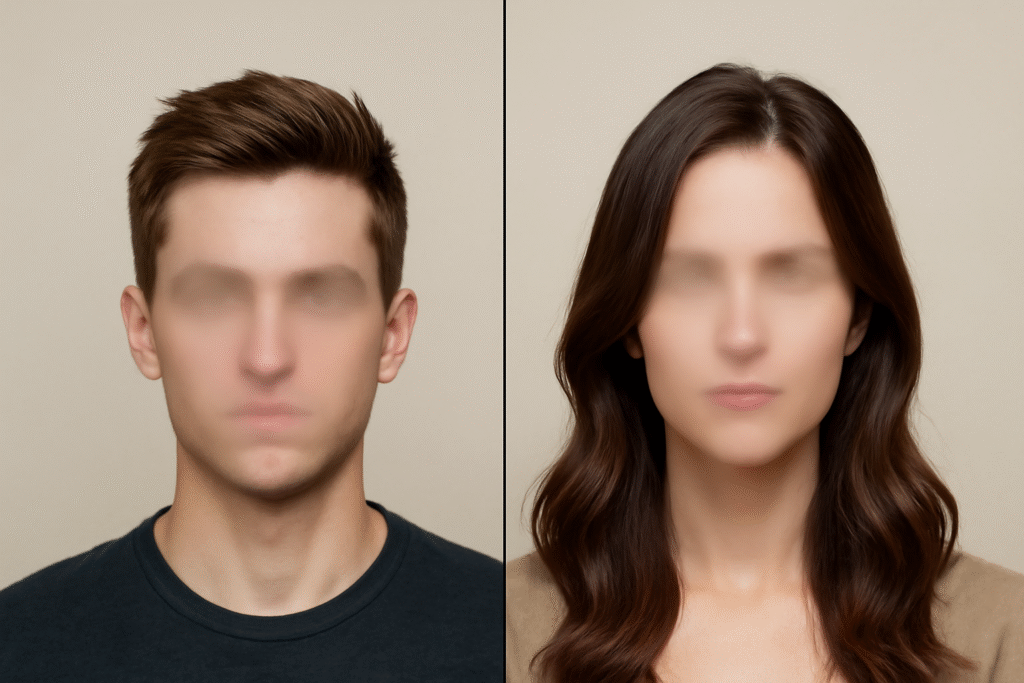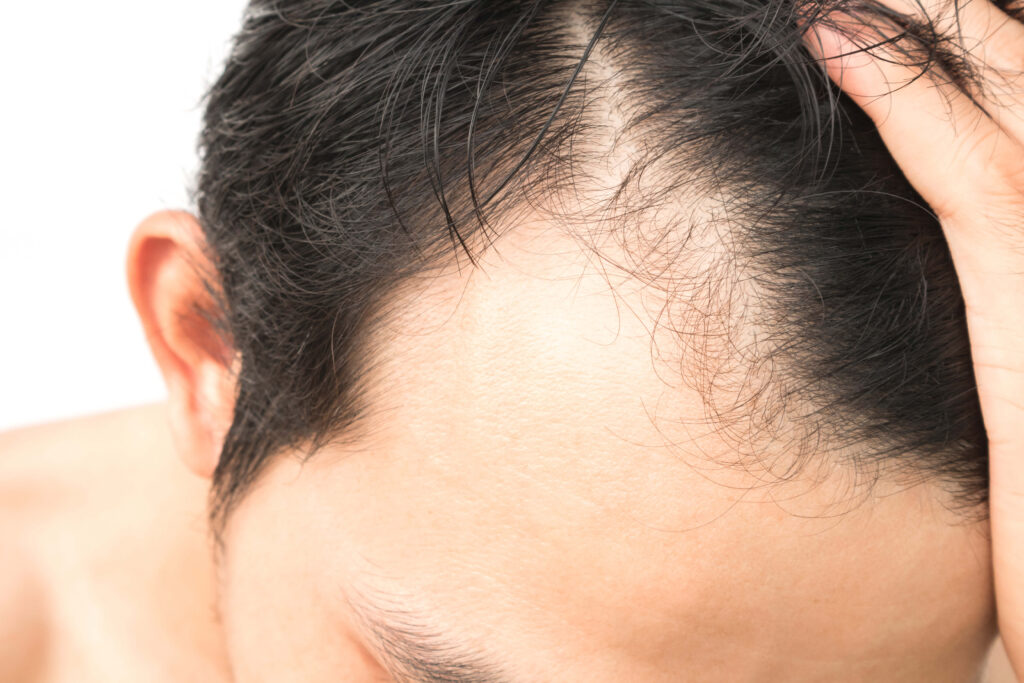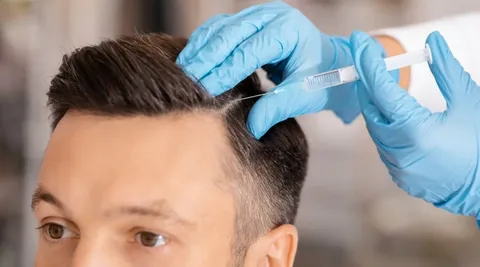Many people struggle to understand the difference between a male vs female hairline, and why it even matters.
Hairline shape, height, and density vary by gender due to hormones, genetics, and aging. Knowing these differences can help identify early signs of hair loss, choose the right treatment, or plan hairline restoration more effectively.
In this guide, we break down the key distinctions, expert insights, and real-life recovery advice to help you make informed decisions about your hair.
What Is a Hairline? Understanding the Basics
Definition and Function
Your hairline is where your forehead ends and scalp hair begins. It frames the face and plays a critical role in overall facial harmony, especially in cosmetic procedures and hair restoration.
Why Hairline Patterns Matter for Aesthetics & Identity
The shape of your hairline can influence perceived age, gender, and attractiveness. A well-positioned hairline complements facial proportions, while hairline recession or asymmetry can cause distress and self-consciousness.
Key Differences Between Male and Female Hairlines
Hairline Shape: M-Shaped vs Rounded
- Male hairlines often form an M-shape or widow’s peak with a central point and receding temples.
- Female hairlines tend to be more rounded and even across the forehead.
Hairline Height: Receding vs Low
- Men usually have higher hairlines due to natural maturation or early hair loss.
- Women generally maintain a lower hairline unless affected by medical conditions or genetics.
Density and Distribution
- Male hairlines often show frontal thinning.
- Female hairlines typically retain density but may thin diffusely across the scalp.
Forehead Proportions and Symmetry
- Male foreheads appear taller due to recession.
- Women tend to have smaller forehead ratios, especially in aesthetic surgeries.

Causes of Hairline Differences
Genetic Factors
Genes play a significant role. Androgenetic alopecia, commonly inherited, affects men more aggressively.
Hormonal Influences (Testosterone, Estrogen, DHT)
- DHT (Dihydrotestosterone) binds to hair follicles and causes shrinkage, more active in men.
- Estrogen offers some protection, which is why women typically experience slower, less visible hairline changes.
Aging and Hairline Maturation
Both genders experience hairline maturation during late teens to early adulthood, though men see more prominent shifts.
Environmental & Lifestyle Triggers
Stress, diet, tight hairstyles, and poor scalp care can accelerate hairline changes in both sexes.
Common Hairline Concerns in Men and Women
Male Pattern Baldness (Androgenetic Alopecia)
Affects over 50% of men by age 50. Starts with temple recession and crown thinning.
Female Frontal Fibrosing Alopecia
A form of scarring alopecia causing recession across the front hairline, mostly in postmenopausal.
Stress-Related Hairline Thinning
Common in both genders, especially after trauma, illness, or hormonal shifts.
Postpartum or Menopausal Hairline Changes (Women)
Hormonal drops can trigger temporary or permanent thinning near the temples or front.
How Hairlines Change Over Time: What’s Normal?
Teenage to Adult Hairline Transition
It’s normal for teenage males to develop a more mature, slightly higher hairline. For women, hairline shape usually remains consistent.
Early Signs of Hairline Recession
- Thinning at the temples
- Noticeable shedding in the shower
- Wider parting line
When to Be Concerned
- Rapid changes within months
- Visible scalp
- Itchy, inflamed edges (may indicate a medical condition)
Diagnosing and Assessing Hairline Health
Self-Assessment Tips
- Compare old photos
- Track changes monthly
- Use mirrors or phone apps for consistency
When to See a Dermatologist
If you notice sustained thinning, irritation, or asymmetry, consult a certified dermatologist for scalp evaluation.
What a Trichologist Can Tell You
Hair specialists can assess follicular health, hair density, and underlying causes.
Tools for Hairline Analysis
- Apps: Hair loss tracking tools
- Clinics: Dermoscopy, digital scalp imaging

Treatment Options Based on Hairline Type and Gender
Hair Transplants: Different Approaches for Men vs Women
- Men often require restoration of temple points and the crown.
- Women typically need hairline lowering or density filling without shaving the donor site.
Topical & Oral Medications (e.g., Minoxidil, Finasteride)
- Minoxidil: Safe for both sexes
- Finasteride: Not recommended for women of childbearing age due to hormonal effects
Platelet-Rich Plasma (PRP) Therapy
A natural, non-surgical option that stimulates follicle growth using your plasma.
Cosmetic Enhancements: Hairline Lowering, Micropigmentation
Non-invasive options for enhancing hairline appearance or symmetry.
Pro Tip: Always consult a specialist before beginning any treatment, especially if you’re experiencing rapid hairline changes.
Expert Opinions: What Dermatologists & Surgeons Say
Male vs Female Hairline Restoration – Key Surgical Differences
According to Dr. Rana Irfan, board-certified hair transplant surgeon, “Designing a female hairline requires precise attention to symmetry and density—it’s not just about filling gaps but preserving feminine contours.”
Patient Suitability by Gender
- Men may need larger donor areas.
- Women often seek conservative, natural results.
Recovery Timelines by Procedure Type
- PRP: 1–2 days of downtime
- FUE Transplant: 7–14 days for healing
- Hairline Lowering Surgery: 2–3 weeks of recovery

Real Stories: Patient Case Studies & Hairline Journeys
Case 1: Male Patient – Receding M Hairline to Full Coverage
36-year-old patient underwent 2,000 grafts via FUE, restoring frontal density and natural shape.
Case 2: Female Patient – Forehead Reduction Surgery Results
28-year-old female chose surgical lowering for aesthetic balance—achieved a natural, rounded hairline with minimal scarring.
Visual Before & After Gallery

FAQs: Male vs Female Hairlines
Can women experience a receding hairline too?
Yes, especially post-menopause or due to medical conditions like frontal fibrosing alopecia.
Is it normal for a male’s hairline to change after puberty?
Yes, a mature hairline forms naturally in late teens or early 20s.
Can hormones reverse hairline recession?
Hormone therapy can slow or stabilize hair loss, especially in women, but rarely regrows lost follicles without additional treatment.
Are hair transplants equally effective for both genders?
Yes—with proper planning. Techniques and goals differ, but success rates are high in both.
Personalized Hairline Consultation
Ready to take control of your hairline journey? Book a personalized consultation with Dr. Rana Irfan in Islamabad—a leading expert in gender-specific hair restoration. Get a professional assessment, treatment plan, and natural-looking results.
